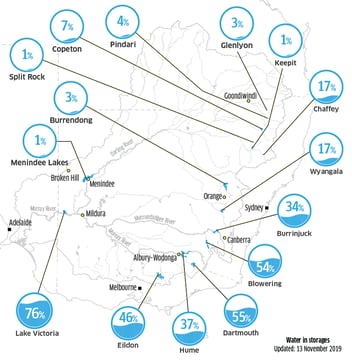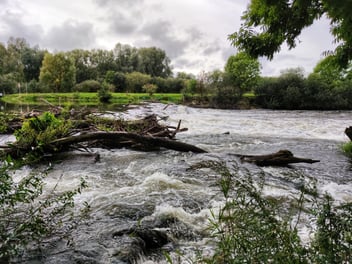Murray-Darling Basin drought 'most severe' on record
The Murray-Darling Basin (MDB) is in the midst of the worst drought in over a century, with record high daytime temperatures and evaporation rates compounding the lack of rain.
Speaking during a Bureau of Meteorology (BOM) update last week, climatologist Dr David Jones said the current drought had surpassed the Federation drought, the World War II drought and the Millennium drought in severity.
“For droughts lasting two to three years, this is the most severe we've seen in terms of the rainfall totals and probably also in terms of runoff into dams,” Jones said.
“It’s the most severe in 120 years of records.”
While not everywhere in the country is experiencing its worst drought, BOM water sector engagement lead Matthew Coulton said every state had experienced a decline in storage levels over the past 12 months.
“Most storages in south-east Australia – our biggest storages – are looking pretty poor at below 50%,” Coulton said.
“Particularly in the northern MDB – those are very close to empty.”
Jones pointed to three main factors making this current drought so bad: warm conditions in the Pacific and Indian Oceans leading to reduced rainfall over Australia; an increase in temperature; and a reduction in wet season rainfall in southern Australia.
He said it would take record-high rainfall in the next three months to provide some material relief, but that this was unlikely.
"Our climate forecasts for the next three months show well below average chances of exceeding median rainfall throughout most of the MDB, especially in the north," Jones said.
“It doesn’t mean it won’t rain, it doesn’t mean we won’t see some good rain in pockets, but the prospects for good relief rainfall in the next three months unfortunately don’t look too good.”
Aside from the deluge brought by Queensland’s Tropical Cyclone Trevor in March, Australia’s last very wet year was 2016. Coulter said the rain during this period helped to fill dams but had little impact on groundwater.
This is having a noticeable impact on some of the country’s largest aquifers, including the Gwydir aquifer near Moree and the Namoi aquifer at Wee Waa.
“The seasonal drawdown in those aquifers is more than the recharge we’re getting each year, and we’re not getting the level of recovery that we see in our surface water storages following very wet events,” Coulter said.
Towns at risk
The northern New South Wales (NSW) town of Guyra has been dubbed ‘ground zero’ of the drought. It began trucking in water from the nearby Armidale Water Treatment Plant in June, when the Guyra dam was sitting at less than 27%. This has since dropped to 24%.
Armidale Regional Council Mayor Simon Murray said carting water was a temporary measure designed to secure the town’s supply until the Malpas Dam pipeline comes online, hopefully in mid-August.
“However, it became clear Guyra’s current water shortage, and the town’s rate of consumption, will leave the town without water before the pipeline is completed and fully operating,” Murray said.
Level 4 water restrictions, which prohibit residents from watering gardens and filling swimming pools, had brought a slight reduction in consumption. But as the town uses about 15% more water per household than the national average, Murray said more needed to be done.
Guyra in NSW is "ground zero" for the #drought. It has officially run out of water.
Each day six tankers drive up the hill to dump water into the treatment plant and keep the town alive, reports @mjrowland68 pic.twitter.com/JBWZ7nWudB
— News Breakfast (@BreakfastNews) July 15, 2019
Meanwhile, other towns across NSW and Queensland are at risk of running out of water within the next 12 months.
Armidale, Cobar, Dubbo, Nyngan, Narromine, Tamworth and Tenterfield have all been feeling the pressure, as have Warwick and Stanthorpe across the border in Queensland.
Burrendong Dam, which services towns including Cobar, Dubbo, Nyngan and Narromine, is sitting at 5.3%, and could be empty within 12 months without considerable rainfall.
In Tenterfield, dam levels have hit 33%, while the dam servicing Tamworth's 60,000 residents is at just 23% and dropping.
WaterNSW is planning to extend Tamworth’s water supply by constructing a temporary weir on the Peel River. Water released from Chaffey Dam will flow down the river until it reaches the weir before being pumped to the Dungowan pipeline.
The aim is to reduce evaporation and maximise the amount of water available.
Orange “leading the state”
Although there were reports that the NSW town of Orange was at risk of running out of water within the next six months, Mayor Reg Kidd said this is untrue.
He said Orange City Council had invested in water infrastructure that will ensure the city has enough water to last at least 12 to 18 months, assuming there is no rain.
“We’ve raised the dam wall, we’ve built stormwater harvesting schemes, and we’ve built the Macquarie to Orange Pipeline,” Kidd said.
“All of these infrastructure projects have led to a significant increase in our storage, and without them we might have very well been looking at only a few months’ supply left.”
Kidd said Orange residents were “leaders in the state” when it came to water conservation.
“We’re using far less per person per day than other local government areas,” he said.
“We’ve been in this position before, and we have worked hard in recent years to develop infrastructure to help shore up Orange’s supply.”
While the drought doesn’t look like it will break any time soon, the Coalition’s drought fund bill, which passed the Lower House earlier this week, could deliver some financial relief for communities. The fund will provide $100 million in the next financial year for drought resilience projects, including research, implementing new technologies, improving environmental and natural resource management, infrastructure, and community initiatives.
The bill is expected to pass the Senate.
You can learn more about the drought at the Australian Water Association's NSW State Conference, held in Orange from 8-9 August. To register, click here.



